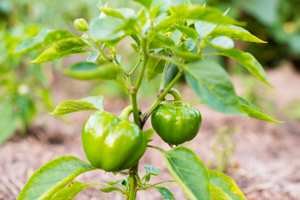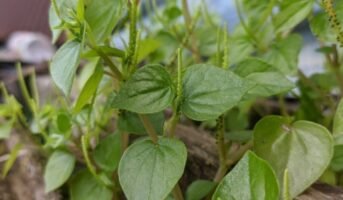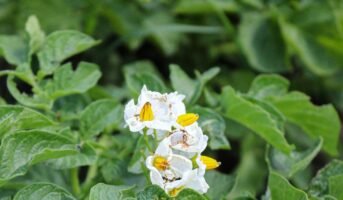The Capsicum plant is one of the most frequently produced crops in the world, used in everything from the colourful pizza toppings of Italian cuisine to the flavorful chilli-chicken of Chinese cuisine.
The Capsicum plant, while a single species, comes in many forms and hues, including red, yellow, green, purple, and even black! In addition to being used as spices and veggies, the Capsicum plant has also been included in pharmaceuticals due to its exceptional health advantages.
See also: Exotic vegetables to grow indoors
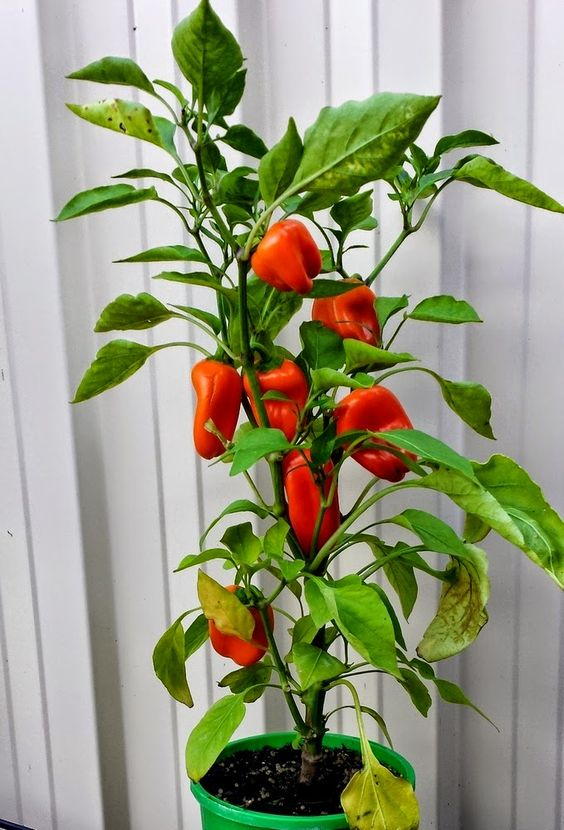
Source: Pinterest
Capsicum plant: Key facts
| Common name | Capsicum, bell pepper |
| Botanical name | Capsicum annum |
| Family | Solanaceae |
| Height | Up to 1 metre |
| Water | Moderate |
| Sunlight | Full |
| Flower colour | White |
What you need to know about capsicum plants?
It is possible for capsicum plants to endure more than one season and mature into a huge shrubby perennial herb if there are no frosts throughout the winter. The single flowers can range in colour from off-white to a purplish hue, and the stem can grow to a height of up to 60 centimetres (24 inches) in length.
When mature, the fruits are peppers that might have a green, yellow, orange, or red colouration. Even though the species can thrive in a wide range of frost-free areas, C. annuum produces the greatest fruit when grown in hot, arid regions.
Capsicum plant: How to grow from seeds?
Capsicum plants need a lot of sunlight, so pick a nice, sunny area to put them in. This plant needs full sun in order to thrive. Capsicum plants require a climate that is neither too hot nor too cold to thrive. You should select a location that has some shade and some sun. Get a pot, watering can, potting soil, heritage capsicum seeds, and a trowel, and you’re ready to plant your peppers.
If you use high-quality potting soil, your plant will thrive. Vermicompost, cocopeat, and sand in equal amounts can be used. Fill the container with the potting soil, then lightly scratch the surface with your fingers before scattering the seeds. Put a little layer of dirt over these seeds. Add a light mist of water to the top to keep the soil moist. Avoid waterlogging, but don’t let the soil dry out, either.
Either place the seeds straight into the soil or germinate them indoors before transferring the seedlings (approximately 10 to 15 cm tall plants) outside. Prior to transplanting the Capsicum seedlings, amend the soil with compost, manure, compost tea, or Panchagavya. Plant the seedlings around 30 cm apart.
- Germination rates for capsicum are highest at temperatures between 18 and 35 degrees Celsius.
- Put your plants where they will get at least four to five hours of sunlight a day.
- Separate your plants by at least 12-15 inches.
- Capsicums thrive in the warm, humid conditions of the north Indian summer. On the other hand, in the southern regions of India, it can be grown year-round.
- As the plant begins to produce fruit, it will require short stakes for balance. Capsicum can lose its blossoms in extremely hot or cold climates to conserve energy, rendering it unproductive. Therefore, planting them in the proper season is essential for a successful crop. Capsicum is also suitable for container cultivation.
Capsicum plant: Propagation
You can easily grow capsicum plants from seeds obtained from a healthy harvest. However, it’s essential to remember that the seeds from hybrid varieties cannot be used for propagation. Alternatively, capsicum plants can also be propagated through stem cuttings. All you need to do is gather some healthy stems and remove any flowers or leaves before planting them in pots filled with compost. Cover the pot with plastic and place it in a warm and sunny location for two weeks. Once the first true leaf appears, remove the plastic and transplant it to your garden.
Capsicum plant: Care tips
Here are some tips to maintain capsicum plants in your home garden.
Capsicum plant: Watering requirement
Watering is the most difficult step. Capsicums require a lot of water, but that does not imply they should be submerged! The soil must always be damp. In addition, remember not to water the vegetation. The result will be a fungal infection. It is a good practice to water the plant’s base. Never allow the soil to become dry.
Capsicum plant: Pruning requirement
It is always a good idea to pinch the plant’s growing tips. This will promote bushier plant growth. Capsicum does not require pruning, but it can be performed if desired.
Capsicum plant: How to harvest?
Capsicum plants that have been properly cared for will begin to produce fruit in as little as two months. When your capsicums reach the size of a tennis ball, and the skin becomes smooth and glossy, it is time to begin harvesting them. If you pick them before they are entirely ripe, they will continue to ripen as long as you keep them in a sunny location. When the capsicums are ready, remove them from the plants.
Capsicum plant: Pests
Aphids and whiteflies are the most common pests of capsicum. Utilise organic pesticides like Neem oil to treat them. In places with greater humidity levels, adequate plant spacing is vital for ensuring airflow and mitigating many possible mould issues.
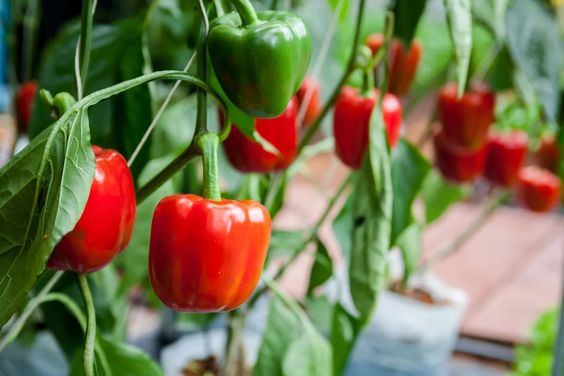
Source: Pinterest
Capsicum plant: Uses
- Useful in pain relief.
- Fruit can be eaten.
- Useful in digestion.
Capsicum plant: Benefits
- Beneficial to the eyes.
- Help with weight loss.
- Good for skin.
- Possessing anti-ageing qualities.
- Beneficial for those with diabetes.
- Beneficial contribution of iron.
- Beneficial to cardiovascular health.
- Increases immunity
Capsicum plant: Side effects
Even if there are no deadly or chronic negative effects linked with the use of capsicum, it is best to seek the opinion of a qualified medical professional before using the plant. It is recommended that youngsters, pregnant women, and breastfeeding moms limit their frequent consumption of capsicum. Diarrhoea, heartburn, and upset stomach are known negative effects of unrestricted usage.
FAQs
Which type of bell pepper is the most potent?
Greater amounts of antioxidants, including Vitamins C and E, and beta-carotene, are found in red capsicums.
Is capsicum beneficial for the skin?
Consuming capsicum helps maintain clear skin and avoids rashes and acne.
Housing News Desk is the news desk of leading online real estate portal, Housing.com. Housing News Desk focuses on a variety of topics such as real estate laws, taxes, current news, property trends, home loans, rentals, décor, green homes, home improvement, etc. The main objective of the news desk, is to cover the real estate sector from the perspective of providing information that is useful to the end-user.
Facebook: https://www.facebook.com/housing.com/
Twitter: https://twitter.com/Housing
Email: editor@housing.com
